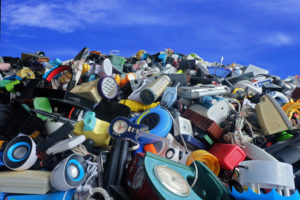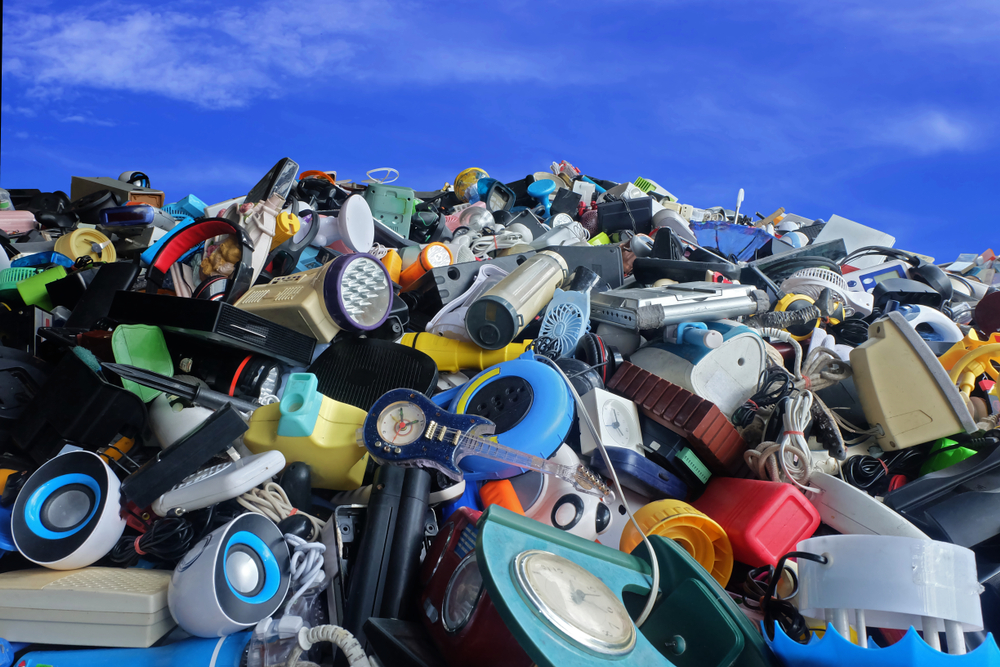

According to a recent World Economic Forum Report, 50 million tonnes of electronic and electrical waste is produced each year.
To make matters worse, if nothing is done this figure will double to more than 120 million tonnes by 2050.
This is an astronomical amount of waste – processed non-renewable resources all sitting above ground. Many argue this huge amount represents an incredible opportunity.
Let’s take a moment to think about this abundance of ‘above-ground’ resources and what it means:
FACT: There is 100 times more gold in a tonne of mobile phones than in a tonne of gold ore. [1]
FACT: Harvesting the resources found in used electronics produces substantially less carbon-dioxide than mining.
FACT: Functioning electronic goods are worth more than the materials they contain. Choosing to extend their useful life brings an enormous economic and environmental benefit.
Transitioning towards a circular economy is the best way to tackle this challenge and mitigate the environmental harm it poses.
To achieve this, we need:
- Vision: We need to collectively rethink the manner we perceive and manage end of life electronics, and convey an emotive vision that government, consumers and industry can rally around.
- Awareness & Education: More needs to be done to better educate the public about this global challenge and the opportunity it presents.
- Collaboration: This is key. We need to work with all stakeholders in a deliberative process to bring about change.
- Action: Coordinated action is needed within and across national borders by all parties including governments, manufacturers and consumers.
The dramatic increase in e-waste is undeniably one of the greatest challenges today. Government and industry has responded through waste control mechanisms, import restrictions, and mandatory and voluntary product stewardship schemes.
Over a year into the start of China’s National Sword policy, we are still adjusting to the new world order – one that continues to evolve – almost daily. Recently China announced it will also prohibit the import of low-grade copper scrap and has signalled its intention to ban the import of all solid waste by 2020.
While many in the recycling industry have been holding out hope for a policy reversal, it is unlikely that things will ever go back.
As other nations in South-East Asia follow China with their own waste import bans, Australia (along with the EU, North America, and other developed nations) is under significant pressure to develop its own materials processing capacity.
More recently, the New South Wales state government has designated e-waste as a priority stream for funding. Only time will tell the shape this support will take, and the impact it will have.
It is obvious that the next few years are likely to be challenging for recyclers as downstream supply chains rapidly reorganise and regulatory risks remain uncertain.
An abundance of opportunity
According to the European Electronics Recycling Association, in a recent published report, this is an ideal opportunity for the instigation of a circular economy.

The combined effect of China’s National Sword and greater public awareness of waste is creating an environment which can drive innovation. This can be seen through the creation of:
- The microfactory recycling model, which uses innovative methods to maximise value recovery from waste through its ability to be transported to the source;
- The utilisation of low-energy and low-impact metal recovery and purification technologies (e.g. low temperature methods such as environmentally friendly hydrometallurgy, or bio hydrometallurgy); and
- The development of automated and robotic dismantling and sorting processes that dramatically improve economies and efficiencies of scale.
Valued at around $62.5 billion annually, we need to look beyond the mountain and see the incredible opportunity locked up in e-waste. Of the 217 global economies, this figure is greater than the GDP of the bottom 140 nations. In the right hands, all this e-waste is worth considerably more.
Materials efficiency, recycling infrastructure and scaling up the volume and quality of recycled materials to meet the needs of all electronics supply chains is essential.
A new vision for the production and consumption of electronic and electrical goods is needed.
It is easy for e-waste to be framed as a post-consumer problem, but the issue encompasses the entire lifecycle of the devices everyone uses and how we choose to manage them.
Designers, manufacturers, investors, consumers, and policy-makers have an instrumental role to play.
The future is literally in our hands.
Let’s regard this year as an inflection point in history. One that represents an opportunity for businesses, policymakers and consumers to make a difference.
Those who can rethink the value chain for electronics and prioritise dematerialisation and closed loop systems, will ultimately have an incredible advantage in the market place.
Innovative technologies do not have to mean more e-waste; they can (and should) mean less.
The prevailing and somewhat draconian industrialised business model of ‘take, make and dispose’ has dreadful consequences for society, and the environment.
Yes – it is time for a system reset.
Together with our Members and Collection Partners, ANZRP is committed to the successful implementation of a circular economy.
[1] Baldé, C. P., et al., The Global E-waste Monitor 2017, UNU, ITU, ISWA, 2017 – www.itu.int/en/ITU-D/Climate-Change/Pages/Global-E-waste-Monitor-2017.aspx



